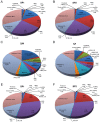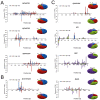Identification and characterization of argonaute protein, Ago2 and its associated small RNAs in Schistosoma japonicum
- PMID: 22860145
- PMCID: PMC3409120
- DOI: 10.1371/journal.pntd.0001745
Identification and characterization of argonaute protein, Ago2 and its associated small RNAs in Schistosoma japonicum
Abstract
Background: The complex life cycle of the genus Schistosoma drives the parasites to employ subtle developmentally dependent gene regulatory machineries. Small non-coding RNAs (sncRNAs) are essential gene regulatory factors that, through their impact on mRNA and genome stability, control stage-specific gene expression. Abundant sncRNAs have been identified in this genus. However, their functionally associated partners, Argonaute family proteins, which are the key components of the RNA-induced silencing complex (RISC), have not yet been fully explored.
Methodology/principal findings: Two monoclonal antibodies (mAbs) specific to Schistosoma japonicum Argonaute protein Ago2 (SjAgo2), but not SjAgo1 and SjAgo3, were generated. Soluble adult worm antigen preparation (SWAP) was subjected to immunoprecipitation with the mAbs and the captured SjAgo2 protein was subsequently confirmed by Western blot and mass spectrometry (MS) analysis. The small RNA population associated with native SjAgo2 in adult parasites was extracted from the immunoprecipitated complex and subjected to library construction. High-through-put sequencing of these libraries yielded a total of ≈50 million high-quality reads. Classification of these small RNAs showed that endogenous siRNAs (endo-siRNAs) generated from transposable elements (TEs), especially from the subclasses of LINE and LTR, were prominent. Further bioinformatics analysis revealed that siRNAs derived from ten types of well-defined retrotransposons were dramatically enriched in the SjAgo2-specific libraries compared to small RNA libraries constructed with total small RNAs from separated adult worms. These results suggest that a key function of SjAgo2 is to maintain genome stability through suppressing the activities of retrotransposons.
Conclusions/significance: In this study, we identified and characterized one of the three S. japonicum Argonautes, SjAgo2, and its associated small RNAs were found to be predominantly derived from particular classes of retrotransposons. Thus, a major function of SjAgo2 appears to associate with the maintenance of genome stability via suppression of retroelements. The data advance our understanding of the gene regulatory mechanisms in the blood fluke.
Conflict of interest statement
The authors have declared that no competing interests exist.
Figures






Similar articles
-
Profiles of small non-coding RNAs in Schistosoma japonicum during development.PLoS Negl Trop Dis. 2011 Aug;5(8):e1256. doi: 10.1371/journal.pntd.0001256. Epub 2011 Aug 2. PLoS Negl Trop Dis. 2011. PMID: 21829742 Free PMC article.
-
High-throughput sequencing of RNAs isolated by cross-linking immunoprecipitation (HITS-CLIP) reveals Argonaute-associated microRNAs and targets in Schistosoma japonicum.Parasit Vectors. 2015 Nov 14;8:589. doi: 10.1186/s13071-015-1203-9. Parasit Vectors. 2015. PMID: 26577460 Free PMC article.
-
Identification and characterization of microRNAs and endogenous siRNAs in Schistosoma japonicum.BMC Genomics. 2010 Jan 21;11:55. doi: 10.1186/1471-2164-11-55. BMC Genomics. 2010. PMID: 20092619 Free PMC article.
-
Eukaryotic Argonautes come into focus.Trends Biochem Sci. 2013 May;38(5):263-71. doi: 10.1016/j.tibs.2013.02.008. Epub 2013 Mar 29. Trends Biochem Sci. 2013. PMID: 23541793 Review.
-
Ancient endo-siRNA pathways reveal new tricks.Curr Biol. 2014 Aug 4;24(15):R703-15. doi: 10.1016/j.cub.2014.06.009. Curr Biol. 2014. PMID: 25093565 Review.
Cited by
-
A Biological and Immunological Characterization of Schistosoma Japonicum Heat Shock Proteins 40 and 90α.Int J Mol Sci. 2020 Jun 4;21(11):4034. doi: 10.3390/ijms21114034. Int J Mol Sci. 2020. PMID: 32512920 Free PMC article.
-
MiR-277/4989 regulate transcriptional landscape during juvenile to adult transition in the parasitic helminth Schistosoma mansoni.PLoS Negl Trop Dis. 2017 May 23;11(5):e0005559. doi: 10.1371/journal.pntd.0005559. eCollection 2017 May. PLoS Negl Trop Dis. 2017. PMID: 28542189 Free PMC article.
-
A next-generation microarray further reveals stage-enriched gene expression pattern in the blood fluke Schistosoma japonicum.Parasit Vectors. 2017 Jan 10;10(1):19. doi: 10.1186/s13071-016-1947-x. Parasit Vectors. 2017. PMID: 28069074 Free PMC article.
-
MicroRNA-gene expression network in murine liver during Schistosoma japonicum infection.PLoS One. 2013 Jun 25;8(6):e67037. doi: 10.1371/journal.pone.0067037. Print 2013. PLoS One. 2013. PMID: 23825609 Free PMC article.
-
Comparative Analysis of Transcriptional Profiles of Adult Schistosoma japonicum from Different Laboratory Animals and the Natural Host, Water Buffalo.PLoS Negl Trop Dis. 2015 Aug 18;9(8):e0003993. doi: 10.1371/journal.pntd.0003993. eCollection 2015 Aug. PLoS Negl Trop Dis. 2015. PMID: 26285138 Free PMC article.
References
-
- Blanchard TJ (2004) Schistosomiasis. Travel Med Infect Dis 2: 5–11. - PubMed
Publication types
MeSH terms
Substances
LinkOut - more resources
Full Text Sources
Other Literature Sources

